Learning Unit 9 Mass Wasting and Subsidence Review Questions
![Past R.L. Schuster, U.S. Geological Survey [Public domain], <a href="https://commons.wikimedia.org/wiki/File%3AThistlelandslideusgs.jpg">via Wikimedia Eatables</a> The 1983 Thistle landslide (foreground) dammed the Spanish Fork river creating a lake.](https://opengeology.org/textbook/wp-content/uploads/2016/07/Thistlelandslideusgs.jpg)
10 Mass Wasting
KEY CONCEPTS
At the end of this chapter, students should be able to:
- Explain what
mass wasting is and why information technology occurs on a slope - Explicate the bones triggers of mass-wasting events and how they occur
- Place types of mass wasting
- Identify risk factors for mass-wasting events
- Evaluate landslides and their contributing factors
This affiliate discusses the fundamental processes driving mass-wasting, types of mass wasting, examples and lessons learned from famous mass-wasting events, how mass wasting tin be predicted, and how people can be protected from this potential hazard. Mass wasting is the downhill movement of rock and soil material due to gravity. The term landslide is often used equally a synonym for mass wasting, but
10.one Slope Strength
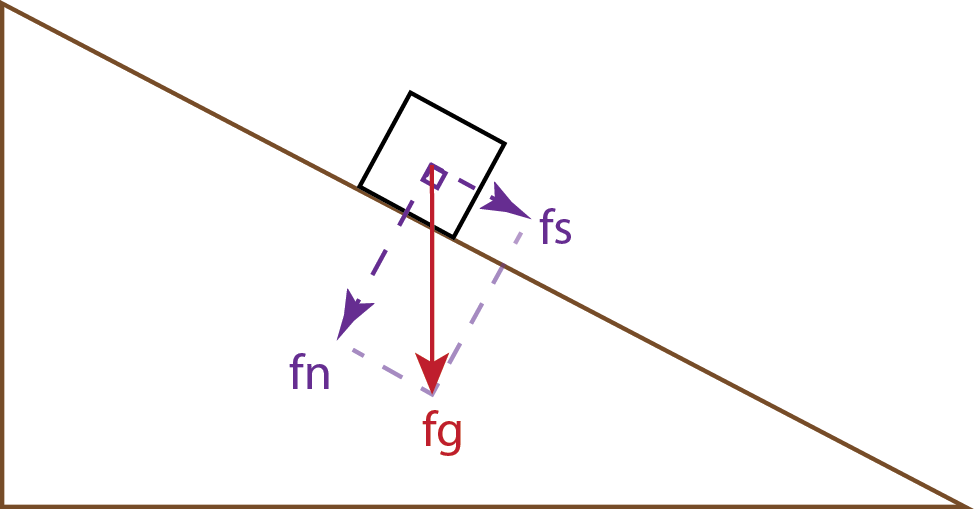
Mass wasting occurs when a slope fails. A slope fails when it is also steep and unstable for existing materials and conditions. Slope stability is ultimately adamant by two principal factors: the gradient angle and the strength of the underlying textile. Forcefulness of gravity, which plays a part in mass wasting, is abiding on the World's surface for the most role, although pocket-size variations exist depending on the elevation and density of the underlying stone. In the figure, a cake of stone situated on a slope is pulled down toward the Earth'south centre past the force of gravity (fg). The gravitational force interim on a slope tin can be divided into two components: the

In the figure, the force vectors alter as the slope angle increases. The gravitational force doesn't modify, but the shear strength increases while the normal strength decreases. The steepest angle at which rock and soil fabric is stable and volition not movement downslope is chosen the angle of repose. The angle of repose is measured relative from the horizontal. When a slope is at the bending of quiet, the shear force is in equilibrium with the normal force. If the slope becomes merely slightly steeper, the
![By Captain Sprite at English Wikipedia (Transferred from en.wikipedia to Commons.) [CC BY-SA 2.5 (http://creativecommons.org/licenses/by-sa/2.5)], via Wikimedia Commons Angle of repose in a pile of sand.](https://opengeology.org/textbook/wp-content/uploads/2016/07/10.1_Angleofrepose.png)
Water is a common factor that tin significantly modify the
Another factor influencing shear strength are planes of weakness in sedimentary rocks. Bedding planes (run into Chapter v) tin can act every bit pregnant planes of weakness when they are parallel to the gradient but less and so if they are perpendicular to the gradient. At locations A and B, the bedding is almost perpendicular to the slope and relatively stable. At location D, the bedding is nearly parallel to the slope and quite unstable. At location C, the bedding is nearly horizontal, and the stability is intermediate between the other ii extremes [1]. Additionally, if clay minerals course along bedding planes, they can blot water and become slick. When a bedding plane of shale (clay and silt) becomes saturated, it can lower the shear force of the rock mass and crusade a
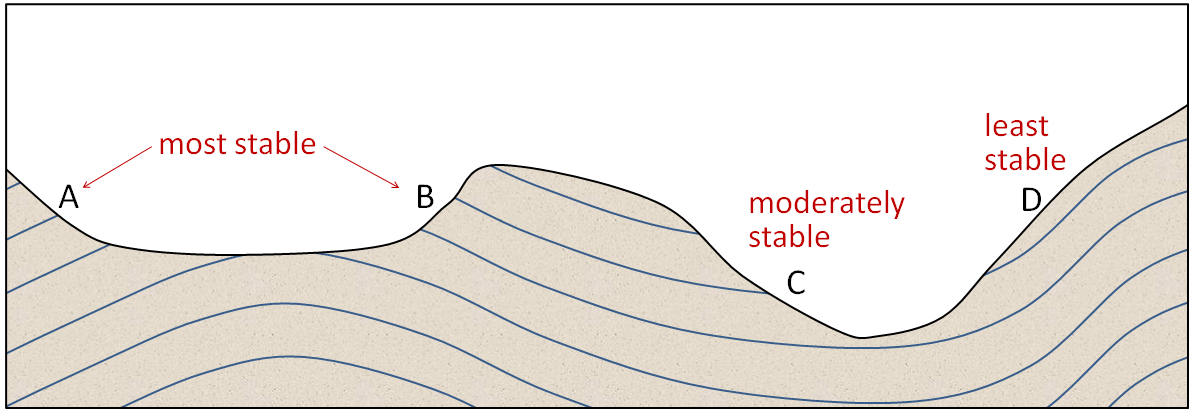
10.ii Mass-Wasting Triggers & Mitigation
Mass-wasting events often have a trigger : something changes that causes a landslide to occur at a specific time. Information technology could be rapid snowmelt, intense rainfall, earthquake shaking, volcanic eruption, storm waves, rapid-stream erosion, or man activities, such every bit grading a new road. Increased h2o content within the slope is the most common mass-wasting trigger. Water content tin can increase due to rapidly melting snow or ice or an intense rain event. Intense pelting events can occur more oft during El Niño years. Then, the west coast of North America receives more than atmospheric precipitation than normal, and landslides become more than common. Changes in surface-water conditions resulting from earthquakes, previous gradient failures that dam upward streams, or human structures that interfere with runoff, such every bit buildings, roads, or parking lots can provide additional h2o to a slope. In the case of the 1959 Hebgen Lake rock slide, Madison Canyon, Montana, the shear force of the slope may have been weakened by earthquake shaking. Most landslide mitigation diverts and drains h2o abroad from slide areas. Tarps and plastic sheeting are often used to drain water off of slide bodies and prevent infiltration into the slide. Drains are used to dewater landslides and shallow wells are used to monitor the water content of some agile landslides.
An
Slope reinforcement can help preclude and mitigate landslides . For rockfall-decumbent areas, sometimes information technology is economical to apply long steel bolts. Bolts, drilled a few meters into a rock face, can secure loose pieces of material that could pose a hazard. Shockcrete, a reinforced spray-on grade of concrete, can strengthen a slope face when applied properly. Buttressing a slide by adding weight at the toe of the slide and removing weight from the head of the slide, tin can stabilize a landslide. Terracing, which creates a stairstep topography, can be practical to help with slope stabilization, but it must exist applied at the proper calibration to be effective.
A different approach in reducing landslide run a risk is to shield, catch, and divert the runout cloth. Sometimes the virtually economic style to deal with a landslide hazard is to divert and wearisome the falling cloth. Special stretchable fencing can be practical in areas where rockfall is common to protect pedestrians and vehicles. Runout channels, diversion structures, and bank check dams can be used to ho-hum debris flows and divert them around structures. Some highways take special tunnels that divert landslides over the highway. In all of these cases the shielding has to exist engineered to a calibration that is greater than the slide, or catastrophic loss in property and life could result.
10.iii Landslide Classification & Identification
Mass-wasting events are classified past type of movement and type of textile, and at that place are several ways to classify these events. The figure and table show terms used. In addition, mass-wasting types often share mutual morphological features observed on the surface, such as the caput scarp—normally seen as crescent shapes on a cliff face up; hummocky or uneven surfaces; accumulations of talus—loose rocky material falling from above; and toe of slope, which covers existing surface cloth.
x.iii.1 Types of Mass Wasting
The about common mass-wasting types are falls, rotational and
| Type of Movement | Primary Material Type and Common Name of Slide | |||
| Bedrock | Soil Types | |||
| Mostly Coarse-Grained | Generally Fine-Grained | |||
| Falls | Rock Autumn | — | — | |
| Stone Barrage | Rock Avalanche | — | — | |
| Rotational Slide (Slump) | — | Rotational Debris Slide (Slump) | Rotational Earth Slide (Slump) | |
| Translational Slide | Translational Stone Slide | Translational Debris Slide | Translational Earth Slide | |
| Flows | — | Droppings Flow | | |
| Soil Creep | — | Creep | Creep | |
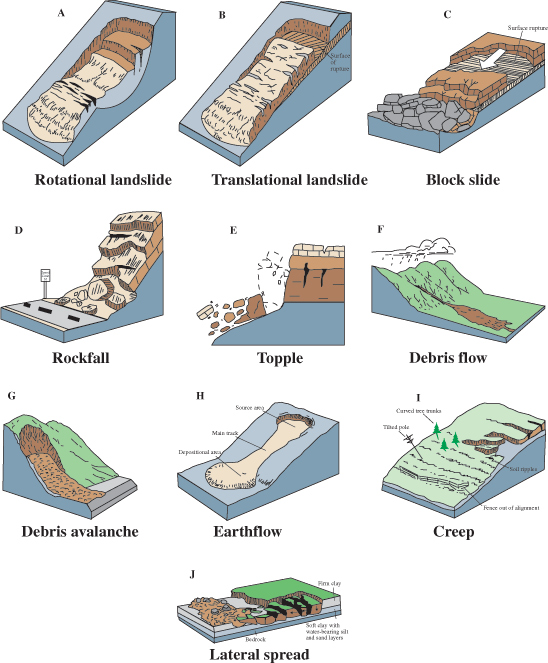
Flows are rapidly moving mass-wasting events in which the loose material is typically mixed with abundant water, creating long runouts at the slope base of operations. Flows are usually separated into debris flow (coarse textile) and earthflow (fine material) depending on the blazon of fabric involved and the corporeality of water. Some of the largest and fastest flows on land are chosen sturzstroms , or long runout landslides. They are still poorly understood, only are known to travel for long distances, even in places without significant atmospheres similar the Moon.
Pitter-patter is the imperceptibly dull downward motility of material acquired by a regular cycle of dark freezing followed by daytime thawing in unconsolidated material such as
Landslide Hazards, David Applegate
10.3.ii Parts of a Landslide
Landslides have several identifying features that tin can exist common across the different types of mass wasting. Notation that there are many exceptions, and a landslide does not have to have these features. Displacement of material by landslides causes the absence of material uphill and the deposition of new cloth downhill, and conscientious observation tin identify the show of that displacement. Other signs of landslides include tilted or outset structures or natural features that would normally be vertical or in identify.
Many landslides have escarpments or scarps. Landslide scarps, like fault scarps, are steep terrain created when motility of the adjacent land exposes a part of the subsurface. The most prominent scarp is the main scarp, which marks the uphill extent of the landslide. As the disturbed cloth moves out of identify, a stride slope forms and develops a new hillside escarpment for the undisturbed textile. Main scarps are formed by movement of the displaced material away from the undisturbed ground and are the visible part of slide rupture surface.
The slide rupture surface is the purlieus of the body of movement of the landslide. The geologic material beneath the slide surface does not move, and is marked on the sides past the flanks of the landslide and at the terminate by the toe of the
The toe of the landslide marks the end of the moving material. The toe marks the runout, or maximum distance traveled, of the landslide. In rotational
Rotational and translational landslides often have extensional cracks, sag ponds, hummocky terrain and force per unit area ridges. Extensional cracks form when a landslide's toe moves forrard faster than the rest of landslide, resulting in tensional forces. Sag ponds are small bodies of water filling depressions formed where landslide movement has impounded drainage. Hummocky terrain is undulating and uneven topography that results from the ground being disturbed. Pressure ridges develop on the margins of the landslide where fabric is forced upward into a ridge structure.
10.4 Examples of Landslides
Landslides in United States
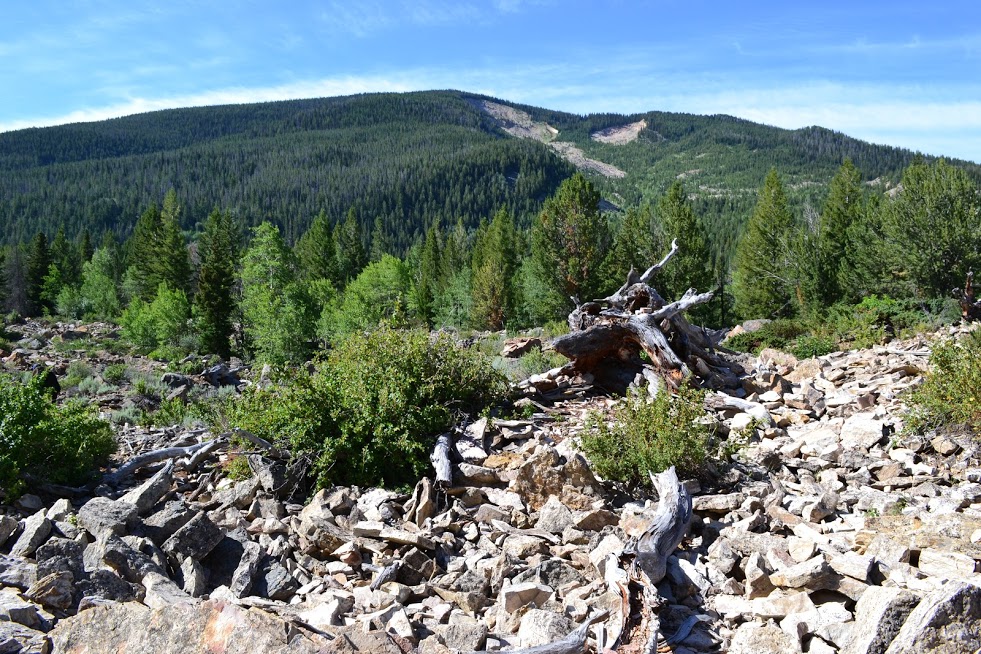
1925, Gros Ventre, Wyoming: On June 23, 1925, a 38 meg cubic meter (l million cu yd) translational rock slide occurred next to the Gros Ventre

A combination of three factors acquired the rock slide: ane) heavy rains and rapidly melting snowfall saturated the Tensleep Sandstone causing the underlying shale of the Amsden Germination to lose its shear strength, 2) the Gros Ventre River cutting through the sandstone creating an oversteepened gradient, and three) soil on top of the mountain became saturated with h2o due to poor drainage. The cross-department diagram shows how the parallel bedding planes between the Tensleep Sandstone and Amsden Formation offered little friction against the slope surface as the river undercut the sandstone. Lastly, the rockslide may take been triggered by an earthquake.
1959, Madison Coulee, Montana: In 1959, the largest convulsion in Rocky Mountain recorded history, magnitude 7.5, struck the Hebgen Lake, Montana area, causing a destructive seiche on the lake (see Chapter nine). The convulsion caused a stone avalanche that dammed the Madison River, creating Convulse Lake, and ran upwards the other side of the valley hundreds of vertical anxiety. Today, in that location are notwithstanding house-sized boulders visible on the slope opposite their starting bespeak. The slide moved at a velocity of up to 160.9 kph (100 mph), creating an incredible air nail that swept through the Rock Creek Campground. The slide killed 28 people, most of whom were in the campground and remain buried at that place. In a manner like the Gros Ventre slide, foliation planes of weakness in metamorphic stone outcrops were parallel with the surface, compromising shear strength.
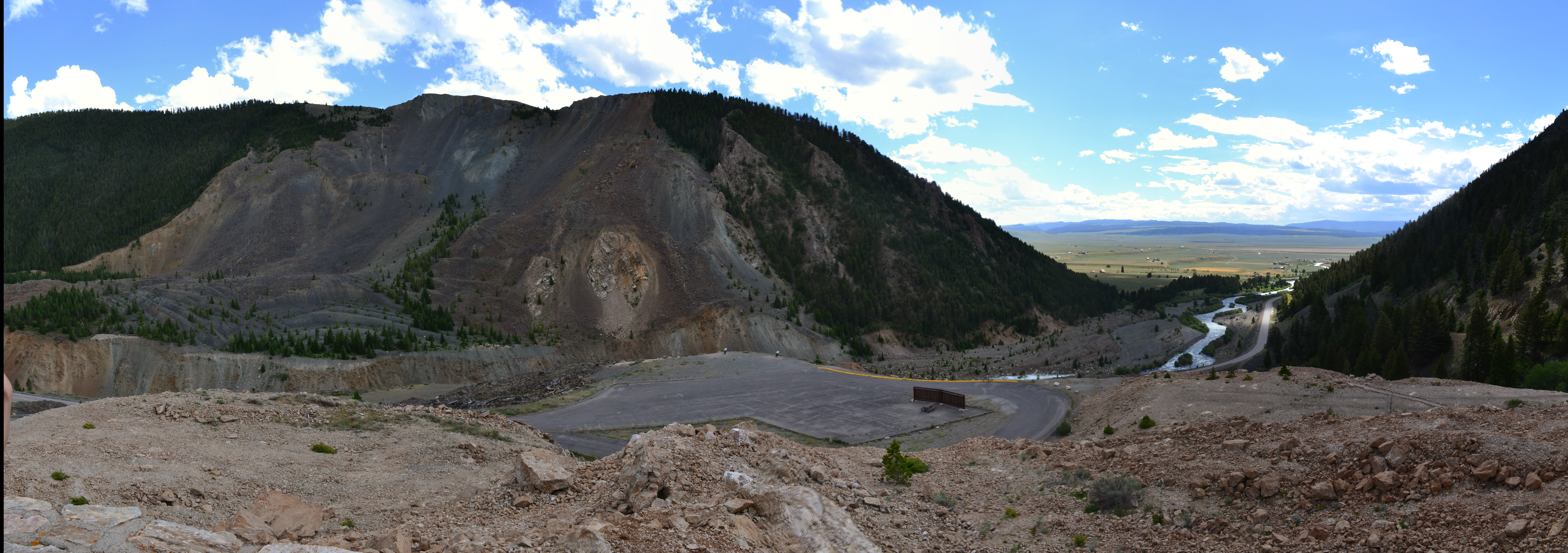
1980, Mount Saint Helens, Washington: On May eighteen, 1980 a v.1-magnitude earthquake triggered the largest landslide observed in the historical record. This landslide was followed past the lateral eruption of Mount Saint Helens volcano, and the eruption was followed by volcanic debris flows known as
1995 and 2005, La Conchita, California: On March 4, 1995, a fast-moving earthflow damaged nine houses in the southern California coastal community of La Conchita. A week later on, a debris flow in the same location damaged five more houses. Surface-tension cracks at the top of the slide gave early alarm signs in the summer of 1994. During the rainy winter season of 1994/1995, the cracks grew larger. The probable trigger of the 1995 event was unusually heavy rainfall during the wintertime of 1994/1995 and ascension groundwater levels. Ten years afterward, in 2005, a rapid-debris catamenia occurred at the finish of a 15-mean solar day flow of most-record rainfall in southern California. Vegetation remained relatively intact as it was rafted on the surface of the rapid flow, indicating that much of the landslide mass simply was being carried on a presumably much more saturated and fluidized layer below. The 2005 slide damaged 36 houses and killed 10 people.
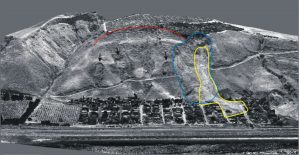
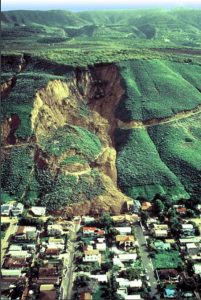
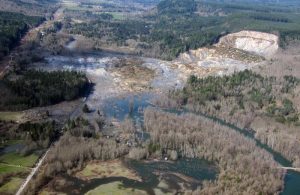
2014, Oso Landslide, Washington: On March 22, 2014, a landslide of approximately 18 million tons (10 million yd3) traveled at 64 kph (40 mph), extended for nearly a one.6 km (1 one thousand), and dammed the Due north Fork of the Stillaguamish River. The landslide covered 40 homes and killed 43 people in the Steelhead Haven community nearly Oso, Washington. It produced a volume of material equivalent to 600 football fields covered in material three thousand (ten ft) deep. The winter of 2013-2014 was unusually wet with most double the average amount of atmospheric precipitation. The landslide occurred in an surface area of the Stillaguamish River Valley historically active with many landslides, but previous events had been pocket-size.
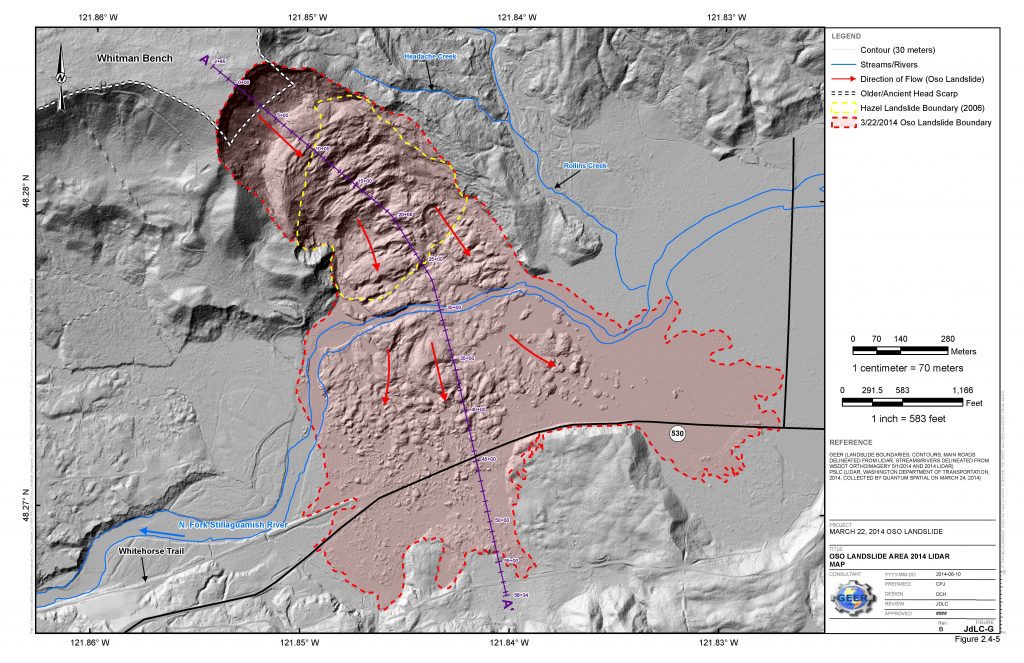
Yosemite National Park Rock Falls: The steep cliffs of Yosemite National Park crusade frequent stone falls. Fractures created to
Utah Landslides
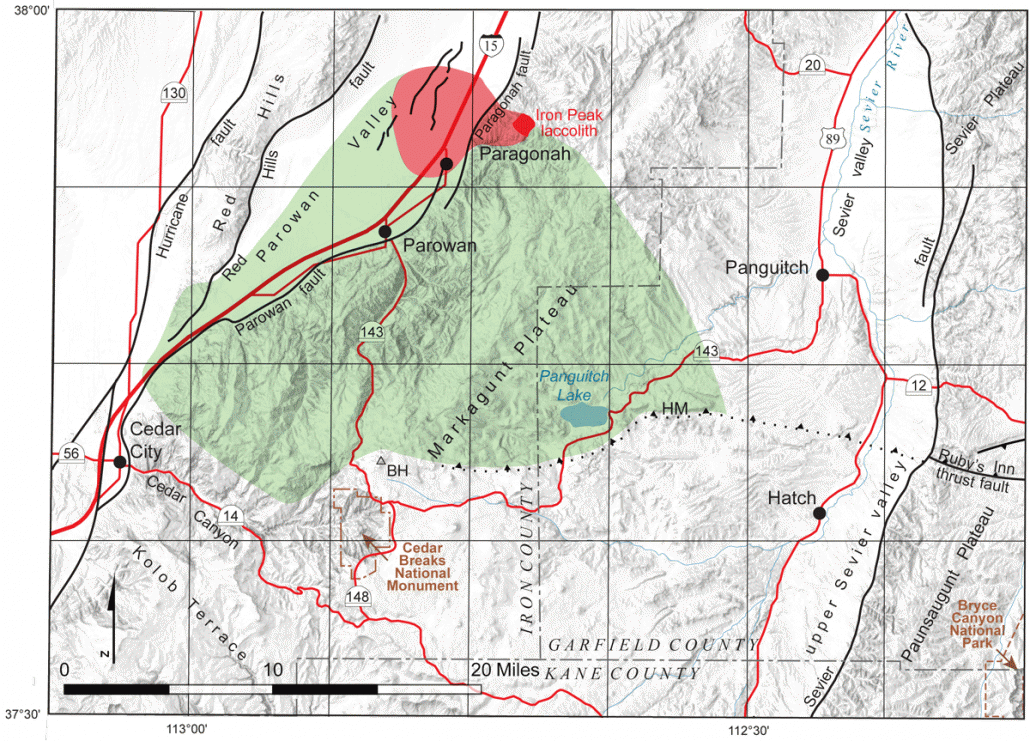
Markagunt Gravity Slide: About 21–22 million years ago, one of the biggest land-based landslides still discovered in the geologic record displaced more than 1,700 cu km (408 cu mi) of material in one relatively fast event. Evidence for this slide includes breccia conglomerates (meet Chapter five), glassy pseudotachylytes, (see Chapter 6), skid surfaces (like to faults) encounter Chapter 9), and dikes (encounter Affiliate vii). The landslide is estimated to comprehend an area the size of Rhode Island and to extend from well-nigh Cedar Metropolis, Utah to Panguitch, Utah. This landslide was likely the result of material released from the side of a growing laccolith (a type of igneous intrusion) encounter Chapter 4), subsequently being triggered by an eruption-related earthquake.
![Past R.50. Schuster, U.Southward. Geological Survey [Public domain], <a href="https://commons.wikimedia.org/wiki/File%3AThistlelandslideusgs.jpg">via Wikimedia Commons</a> The 1983 Thistle landslide (foreground) dammed the Spanish Fork river creating a lake.](https://opengeology.org/textbook/wp-content/uploads/2016/07/Thistlelandslideusgs.jpg)
1983, Thistle Slide: Starting in Apr of 1983 and continuing into May of that year, a tiresome-moving landslide traveled 305 grand (1,000 ft) downhill and blocked Spanish Fork Canyon with an earthflow dam 61 m (200 ft) high. This caused disastrous flooding upstream in the Soldier Creek and Thistle Creek valleys, submerging the town of Thistle. As part of the emergency response, a spillway was synthetic to prevent the newly formed lake from breaching the dam. Later, a tunnel was constructed to drain the lake, and currently the river continues to menstruation through this tunnel. The rails line and United states of america-6 highway had to be relocated at a cost of more than $200 million.
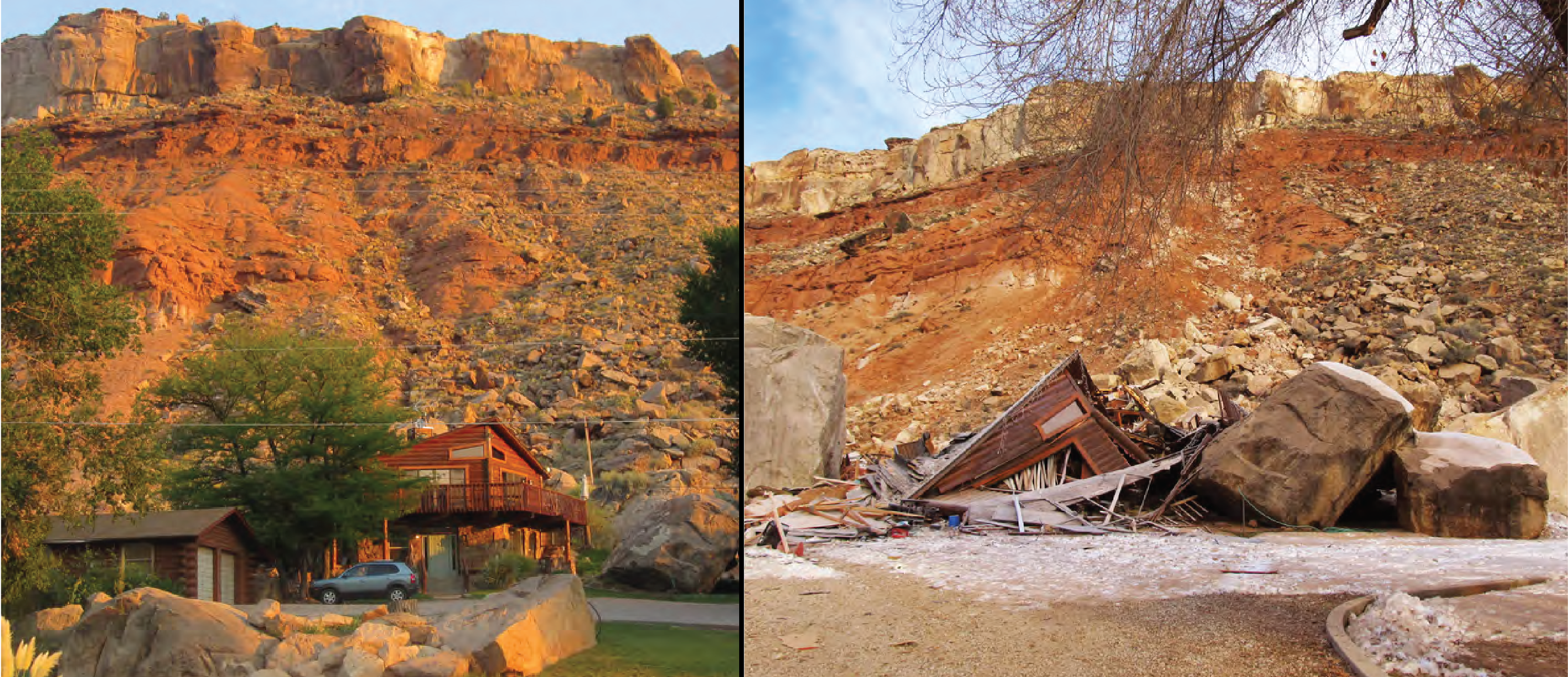
2013, Rockville Rock Autumn:Rockville, Utah is a modest community virtually the entrance to Zion National Park. In December of 2013, a ii,700 ton (1,400 yd3) block of Shinarump Conglomerate fell from the Rockville Bench cliff, landed on the steep 35-degree slope below, and shattered into several large pieces that continued downslope at a high speed. These boulders completely destroyed a house located 375 feet below the cliff (run into the before and after photographs) and killed 2 people inside the home. The topographic map shows other rock falls in the area prior to this catastrophic effect.

2014, North Salt Lake Slide: In Baronial 2014 later on a particularly wet period, a slow moving rotational

Reports from residents suggested that ground cracks had been seen near the top of the gradient at least a yr prior to the catastrophic movement. The presence of easily-tuckered sands and gravels overlying more impermeable clays weathered from volcanic ash, along with recent regrading of the slope, may have been contributing causes of this slide. Local heavy rains seem to accept provided the trigger. In the two years after the landslide, the slope has been partially regraded to increment its stability. Unfortunately, in January 2017, parts of the slope take shown reactivation movement. Similarly, in 1996 residents in a nearby subdivision started reporting distress to their homes. This distress continued until 2012 when xviii homes became uninhabitable due to extensive impairment and were removed. A geologic park was synthetic in the now vacant surface area.
Northward Salt Lake Landslide
2013, Bingham Coulee Copper Mine
10.5 Chapter Summary
Mass wasting is a geologic term describing all downhill rock and
Mass-wasting movement ranges from dull to dangerously rapid. Areas with steep topography and rapid rainfall, such as the California coast, Rocky Mountain Region, and Pacific Northwest, are particularly susceptible to chancy mass-wasting events. By examining examples and lessons learned from famous mass-wasting events, scientists have a amend understanding of how mass-wasting occurs. This cognition has brought them closer to predicting where and how these potentially hazardous events may occur and how people can be protected.
References
- Haugerud, R.A., 2014, Preliminary interpretation of pre-2014 landslide deposits in the vicinity of Oso, Washington: US Geological Survey.
- Highland, L., 2004,
Landslide types and processes: pubs.er.usgs.gov. - Highland, L.M., and Bobrowsky, P., 2008, The Landslide Handbook – A Guide to Understanding Landslides: U.South. Geological Survey USGS Numbered Series 1325, 147 p.
- Highland, L.1000., and Schuster, R.50., 2000, Significant
landslide events in the Usa: United States Geological Survey. - Hildenbrand, T.G., and Hendricks, J.D., 1995, Geophysical setting of the Reelfoot
rift and relations between rift structures and the New Madrid seismic zone: U.S. Geological Survey Professional person Newspaper 1538-E, 36 p. - Hungr, O., Leroueil, S., and Picarelli, L., 2013, The Varnes classification of landslide types, an update: Landslides, 5. xi, no. 2, p. 167–194.
- Jibson, R.West., 2005, Landslide hazards at La Conchita, California: United States Geological Survey Open-File Report 2005-1067.
- Lipman, P.W., and Mullineaux, D.R., 1981, The 1980 eruptions of Mount St. Helens, Washington: Usa Geological Survey USGS Numbered Series 1250, 844 p., doi: 10.3133/pp1250.
- Lund, Westward.R., Knudsen, T.R., and Bowman, S.D., 2014, Investigation of the December 12, 2013, Fatal Rock Fall at 368 West Main Street, Rockville, Utah: Utah Geological Survey 273, 24 p.
- The states Wood Service, 2016, A Brief History of the Gros Ventre Slide Geological Site: The states Forest Service.
Source: https://opengeology.org/textbook/10-mass-wasting/